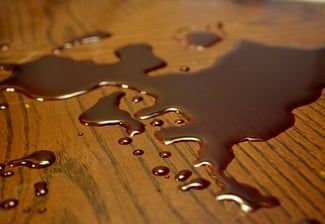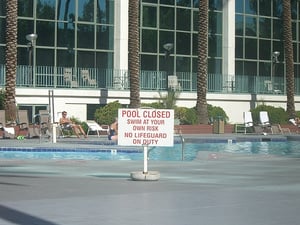How To Clean Up Blood And Bodily Fluids
Exposure to potentially hazardous blood is a very real concern for anyone working in a youth-focused or community-based organization. When a child gets a bloody nose or someone stubs their toe on the diving board you might be asked to clean it up. After all, we don't want the general public to be exposed to bloodborne pathogens. It is important to remember two things whenever you're asked to clean up blood: Bodily fluid spills may require some specialized equipment depending on their location within the facility, the size of the spill and the type of spill, but most can be cleaned safely using the equipment recommended in OSHA's Bloodborne Pathogen Cleanup Kit. Blood isn't always going to cooperate. Sometimes it won't be easy to simply block off an area and follow general blood cleanup guidelines. Read through the following descriptions to ensure you're prepared for any blood cleanup experience. Spills on hard surfaces often spread over larger areas so it will be necessary to contain the spill quickly. The procedures for cleaning up spills on these surfaces are: Blood spills on carpeted floors are some of the most difficult to clean up due its absorbent nature. The majority of buildings contain at least some amount of carpeting, which is why it is important to know how to respond to spills in these areas. Many of the procedures for cleaning up blood on carpet will be the same as any other area, but there are a few additional concerns. In addition, there is no way to disinfect carpet completely so the best option is to sanitize as thoroughly as possible. The basic protocol for cleaning carpets and removing the threat of bloodborne pathogens is listed below. Please note that even when these steps are followed there is no guarantee that the threat of bloodborne pathogen exposure is 100% eliminated. Like bodily fluid spills on carpet, spills on furniture are difficult to clean as well. There are, however, certain steps you can take to make sure it is as clean and safe as possible. As is the case with blood spills on carpet, it is important to contain the spill as quickly as possible. Cleaning blood off of furniture depends on what type of furniture is contaminated. Cloth furniture needs more treatment than wood or metal furniture. Depending on the type of cloth furniture and the degree of the spill, the best cleaning method is to remove the cloth covering, if possible, and launder it by itself on a warm wash cycle. If the cloth furniture does not have a removable cover, then it is best to treat the spot as you would a blood spill on carpetand disinfect, let sit, and repeat several times. There are also professional services that can clean furniture much more effectively and thoroughly if the spill is severe enough. Blood spills on metal and wood furniture are not as laborious as those on cloth furniture, but it is important to point out that bloodborne pathogens are still a threat. Metal, wood and any other non-porous furniture should be cleaned just like ablood spill on a non-carpeted surface. From the CDC: Germs found in blood (for example, Hepatitis B virus or HIV) are spread when infected blood or certain body fluids get into the body and bloodstream (for example, by sharing needles or by sexual contact). Chlorine kills germs found in blood and CDC is not aware of any instances in which a person has become infected with these germs after being exposed to a blood spill in a pool. Blood spills outdoors present a unique set of challenges. Cleaning bodily fluid spills from dirt or grass is difficult, but since there is still a potential for exposure there a few measures to take. The easiest step is to re-locate whatever outdoor activity caused the exposure and to block off the affected area. The area should still be disinfected as completely as possible with some form of disinfectant (like bleach) and then thoroughly rinsed with water. Take care to keep the exposed area contained. As with all blood cleanup procedures make sure to wear appropriate PPE and to dispose of it properly after cleanup.
Bloodborne Pathogen Cleanup Supplies Checklist
How to Clean Up Blood in Different Types of Conditions
Blood Spills on Non-Carpeted Floors
 A hard, non-carpeted surface is the most common setting for blood spills. These surfaces include tile, ceramic, vinyl, linoleum, metal, wood, cement, and any other non-absorbent flooring such as a pool deck. Cleaning up blood and other bodily fluids off these surface types is easier than absorbent surfaces, but there are still important steps for you to consider.
A hard, non-carpeted surface is the most common setting for blood spills. These surfaces include tile, ceramic, vinyl, linoleum, metal, wood, cement, and any other non-absorbent flooring such as a pool deck. Cleaning up blood and other bodily fluids off these surface types is easier than absorbent surfaces, but there are still important steps for you to consider.
Blood Spills on Carpeted Floors
Blood Spills on Furniture
Blood Spills in Pools
 For blood in the pool, there is no action required other than attending to the injured individual and making sure the blood does not contaminate anywhere else. A properly maintained pool contains enough chlorine to kill any bloodborne pathogens.
For blood in the pool, there is no action required other than attending to the injured individual and making sure the blood does not contaminate anywhere else. A properly maintained pool contains enough chlorine to kill any bloodborne pathogens.
Blood Spills Outdoors
How To Clean Up Blood And Bodily Fluids
Source: https://www.thesilverlining.com/safety-tips/proper-blood-clean-up#:~:text=Put%20on%20disposable%20gloves.,wipe%20up%20remaining%20bleach%20solution.
Posted by: albrechtfait1939.blogspot.com

0 Response to "How To Clean Up Blood And Bodily Fluids"
Post a Comment